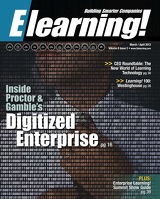Elearning! Magazine: Building Smarter Companies via Learning & Workplace Technologies.
Page 18 of 52
digitalrevolution
spin out of control by the time you get involved. The technology also lets us improve things that are working. For example, we're rolling out a product called Downy Unstopables, a fragrance addition you can add to your wash, and the real- time comments from consumers about the product's characteristics are helping us fig- ure out how best to join in the discussion through our marketing efforts.
FROM FACTORY TO SHELF McDonald: From an operational stand- point, we also believe that to be success- ful we've got to continue to improve pro- ductivity, and being digitally enabled allows for that as well. So we're digitizing our operations everywhere — from our manufacturing plants to the stores where consumers purchase our products. We believe digitization represents a source of competitive advantage. In our manufacturing plants, for exam-
ple, we have systems that allow people to use iPads to download data off the pro- duction line in real time and communicate that to a place where we roll the data up. We're not there yet, but we envision a sys-
tem where I could literally see, on my lap- top, any product at any moment as it goes through the manufacturing line of any one of our plants. And what I'd love to be able
Inevitably, everything's
got to be usable on the smallest, cheapest device possible,
because that's what's going to
get the broadest distribution in a developing market.
to do is see the costs of that product at the same time. It's challenging because accounting systems aren't designed today for operations — they tend to look back- ward — but we're working on integrating our operational system with the financial system to move in that direction. In transport and logistics, we created a
digitally enhanced operational program we call Control Tower that lets us see all the transportation we're doing: inbound, out- bound, raw materials, finished product. We're probably the second- or third-largest user of trucks in the United States, and through this technology we've been able to reduce "deadhead" movement by about 15 percent. This reduces costs and carbon monoxide. In circumstances where we use distributors, a similar interface, called Distributor Connect, lets us link directly with them and help them run their busi- ness. This benefits all of us by improving service and reducing inventory across the supply chain. We want to be digitally connected to
retailers too. For example, we use and sup- port GDSN, which is basically a standard- ized data warehouse that allows us to do commerce with our retail partners in a totally automated way, with no human intervention. The industry association GS1 did a study a few years ago that found that 70 percent of orders between retailers and suppliers had errors. But if everyone used a common data warehouse like GDSN — where the data are kept dynamically cor- rect — that number goes down to virtually zero, and it saves millions of dollars in doing commerce together. Another thing we do is to use our scale
to bring state-of-the-art technology to retailers that otherwise can't afford it. Imagine a small store in the Philippines, for example — a country where I used to live. We can provide sophisticated order- ing applications to help people there run their businesses better than they would be able to otherwise. We have mobile-phone applications that allow retailers to order from us wirelessly or, if they don't have a wireless capability, to order when they go back to their office and set the phone in a base. It's very easy to use. We also have performance standards
that retailers in developing markets can visualize on their phones. For example, we
18 March / April 2012 Elearning!
